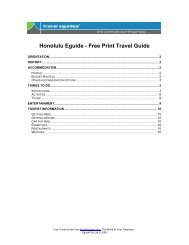Australia Eguide - Travel Guides
Australia Eguide - Travel Guides
Australia Eguide - Travel Guides
You also want an ePaper? Increase the reach of your titles
YUMPU automatically turns print PDFs into web optimized ePapers that Google loves.
174<br />
Tasmania<br />
Tasmania is by far the smallest of the six <strong>Australia</strong>n states, only the <strong>Australia</strong>n Capital<br />
Territory occupying less space. It is also the only island state or territory. Tasmania has<br />
an area of 68,400 square kilometres. It is less than a third of the size of the next smallest<br />
state, its neighbour Victoria, and it represents a little less than one per cent of the total<br />
<strong>Australia</strong>n land mass. Tasmania has a population of 500,000, of which 200,000 live in<br />
Hobart, the capital.<br />
The history of the island of Tasmania goes back a long way. It was originally a part of the<br />
<strong>Australia</strong>n mainland, but was cut off by rising waters some 12,000 years ago. Aborigines<br />
had already been living here for 10,000 to 15,000 years, and, as they became isolated<br />
from their relatives on the other side of the water, they and their culture developed in<br />
different ways.<br />
The first European known to have visited was Abel Tasman. He sighted the west coast at<br />
16:00 on 24th November 1642, but did not appreciate that it was an island separate from<br />
the main <strong>Australia</strong>n continent. It was he who gave it the name of Van Diemen’s Land,<br />
Van Diemen being the Governor-General of the Dutch East India Company in Batavia<br />
(Jakarta), which had commissioned this voyage of exploration.<br />
The island was renamed Tasmania in 1856. Tasmania was also visited by Marion du<br />
Fresne (French) in 1772, Tobias Furneaux (British) in 1773, James Cook (British) in<br />
1777, William Bligh (British) in 1788 and 1792 and Bruni d’Entrecasteaux (French) in<br />
1792. For Cook it was his last visit before he sailed to meet his death in Hawaii, and for<br />
Bligh it was his last stop before sailing to Tahiti, after which the infamous mutiny on the<br />
Bounty occurred. In 1798 George Bass and Matthew Flinders circumnavigated Tasmania<br />
and proved it to be an island, also naming the Bass Strait which separates Tasmania from<br />
Victoria.<br />
The first European settlement of Tasmania was in 1803, and Hobart dates from 1804.<br />
Thus, of all the <strong>Australia</strong>n states, only New South Wales has a longer history of European<br />
settlement than Tasmania.<br />
Some of the fiercest clashes between Europeans and aborigines occurred in Tasmania and<br />
resulted in the virtual extermination of the aboriginal peoples of this state. They<br />
succumbed to European diseases as well as to physical oppression and in 1832 it was<br />
decided to move the remnants of the indigenous peoples to Flinders Island, off the northeastern<br />
coast of Tasmania. However, they were poorly sheltered and cared for there and<br />
the decline in numbers continued. In 1847, the survivors were returned to Oyster Cove,<br />
near Hobart, but by 1876, the last of the group, the famed Trugannini, had perished, to<br />
end a dismal chapter in the history of colonisation.<br />
This depth of history here in Tasmania is not always appreciated by visitors to <strong>Australia</strong>,<br />
who often by-pass this small state, especially as it is an island which is rather expensive<br />
to reach. It is well worth the effort, however, for Tasmania has a beauty of its own and an<br />
Free from <strong>Travel</strong><strong>Eguide</strong>s.com Online <strong>Travel</strong> Information.<br />
©2008 <strong>Eguide</strong> Pty Ltd




